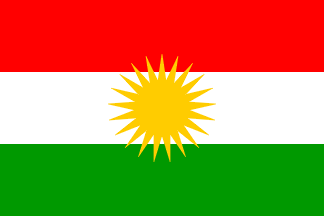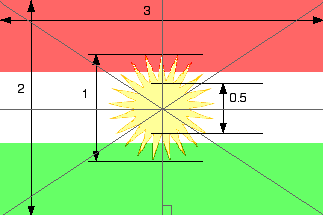 image by Ivan Sache
image by Ivan Sache
FOTW beschäftigt sich mit der Wissenschaft der Vexillologie (Flaggenkunde).
Alle auf dieser Website dargebotenen Abbildungen dienen ausschließlich der Informationsvermittlung im Sinne der Flaggenkunde.
Wir distanziert uns ausdrücklich von allen hierauf dargestellten Symbolen verfassungsfeindlicher Organisationen.
Last modified: 2023-10-14 by ian macdonald
Keywords: sun | mahabad | kdp | puk |
Links: FOTW homepage |
search |
disclaimer and copyright |
write us |
mirrors
Erbil, 10 June 1999
In its ordinary session today, the Council of
Ministers of the Kurdistan Regional Government – KRG discussed a law proposal
concerning raising Kurdistan flag over government buildings in the Kurdish
region along side the Iraqi
flag. The Kurdistan flag comprises of three horizontally arranged colours
red, white and green with a yellow sun in the centre. The proposed law will be
presented soon to the Kurdistan Regional Parliament for approval. Also at the
meeting, the Council of Ministers put forward a proposal to create four more
governorates in the Iraqi Kurdistan. The proposed governorates are Halabja, Soran, Rania and
Akra.
Rezhan, 17 June 1999
Editor's note:: Most of the following information is reproduced from the former website of the Center for Kurdish Political Studies [no longer on-line] with kind permission of its director, Bijan Eliasi.
The aim of this document is to introduce in brief the history of the current National Flag of Kurdistan and to help those who use the Kurdish national flag to reproduce it correctly. The document contains the basic rules for the construction of the flag as well as the standard colors to be used.
The National Flag was first introduced by the leaders of the Khoyboun, ("independence") movement to represent the Kurds in their struggle for independence from the moribund Ottoman Empire. It was subsequently presented to the members of the international delegation at the Paris Peace Conference that devised a plan for Kurdish independence as a part of the Treaty of Sèvres with Ottoman Turkey in 1920. Under the same flag the Khoyboun announced the formation of the first "Kurdish Government in Exile" in 1927 and fought a drawn-out war until 1932, in order to revive the Kurdish national independence, lost since 1848.
In 1946 and the creation of the Republic of Kurdistan at Mahabad, the old "sunny flag" was adopted by its parliament as the official Flag of the Republic. Following these historic background, the National Flag is widely adopted in Kurdistan and has been set aloft by various Kurdish movements and entities in all sectors of the land.
The "sunny flag" has thus been consecrated by the blood of all Kurdish patriots of this century, from tens of thousands who fell in defending the independence movement under the Khoyboun, to the President of the Republic of Kurdistan and his elected cabinet who were hanged in sight of this flag by the foe. The flag was aloft when Dersim was immolated in 1938; it was aloft when wounded Kurds on stretchers were placed before the firing squads in 1980; it was aloft when Kurdish civilians were gassed in their thousands in cities and towns in 1988; it was aloft when millions were driven from their villages and towns that have been set alight since1989; and, it remains aloft everywhere today--150 years after the loss of Kurdish independence--when Kurds are redoubling their perennial struggle to regain their dignity and equality with other nations by reviving their right to choose the course of their own future.
The Kurdish flag has three horizontal bands. The upper stripe is red, the middle one white and the bottom band green. The width of the flag is two-thirds of the length. The primary Kurdish characteristic of the flag is the golden emblem at the center. The sun emblem has a religious and cultural history among the Kurds, stretching into antiquity. The sun disk of the emblem has 21 rays, equal in size and shape. The number 21 holds a primary importance in the native Yazdani religious tradition of the Kurds.
 image by Ivan Sache, 08 May 2003
image by Ivan Sache, 08 May 2003
The diameter of the sun disk is 0.5 without the rays and 1.0 with the rays (considering the 2x3 dimensions of the flag). The rays are keen-pointed at the end, with their sides made of straight lines. No space separates two adjacent rays at their base which touch on the disk, thus leaving no part of the sun disk exposed. The sun emblem is situated at the geometric center of the flag. The sun is placed in such way the vector going through its uppermost odd ray is perpendicular to the length.
I have just learned that the Kurdish Government have apparently adopted the
flag specification I drew up for them a few years ago – see
http://www.kurdistan-parliament.com/KurdishFlag_english.htm.
The flag is in the following colors, according to Pantone matching system:
Christopher Southworth, 05 September 2006
Iraq has on several occasions recognized Kurdish autonomy, but it was usually
a trick which led to war. Most recently, Iraq has not recognized it but the
Kurds have been de facto independent since the Gulf war allies created a
safe-haven. While Kurdish leaders have been warmly received by European heads of
state, nobody wants to recognize Kurdish independence de jure. The dismemberment
of Iraq is considered taboo (enhanced power to Iran, complications of Turkish
claims to the Mosul villayet which was never intended to belong to Iraq, etc.)
Kurdistan had free elections on 19 May 1992, but the presidential vote and
parliamentary vote were pretty much tied at 45% between the Kurdistan Democratic
Party (KDP) and the Patriotic Union of
Kurdistan (PUK). They set up a government of national unity, but the
situation soon degenerated into civil war. (The National Assembly was in Arbil,
the town just seized by Iraq and the KDP from the PUK.)
Stuart A. Notholt, 07 September 1996
The PUK and the KDP control separate
but contiguous areas in the north in which Baghdad's writ has not run
for more than 10 years now. At the moment, they have chosen a
common "prime minister" and government that nominally rules what the
Kurds describe as an autonomous region within Iraq. If I recall correctly, such a
region is provided for in the Iraqi constitution. In fact, the KDP
runs the governorates of Zakhu and about half of Irbil and the PUK
runs the the Suleimaniye governorate and the other half of Irbil. My
understanding of the vexillological implications is that there is a
flag adopted by the government [shown above] of the autonomous region and also
flags for each of the parties, but not separate flags for the
portions of the region that each of the two parties dominate.
Joseph McMillan, 03 April 2003
On 25 July 2009 the six Kurdish provinces of northern Iraq forming the
Kurdistan Regional Government (KRG) held parliamentary and presidential
elections. The KRG has been dominated by the alliance of Kurdistan Democratic Party (KDP) and Patriotic Union of Kurdistan (PUK) that fields a
unified list of candidates called the Kurdistan List. Many Kurds have become
disenchanted with what they view as corruption and nepotism in KPD-PUK
alliance, but opposition parties until now have not presented a significant
challenge.
Gorran (Change) is a new Kurdish political party, founded 3 months ago by
Nawshirwan Mustafa, a defector from the PUK (the party of Iraq President
Jalal Talabani). On election day there was much talk of a possible
upset by Gorran, and Gorran immediately charged instances of fraud in the
election when they failed. The official results show the Kurdistan
List with an absolute majority of 60%, and Gorran with 23.8%, insufficient
even to form a ruling coalition with other smaller parties. But for a very
new party, Gorran's showing significantly changes the nature of Kurdish
politics.
Here are a few links showing the Gorran flag:
http://www.facebook.com/pages/Nawshirwan-Mustafa/15492598300#/photo.php?pid=3023502&id=105226981100
http://www.nytimes.com/2009/07/27/world/middleeast/27kurds.html
http://www.youtube.com/watch?v=5qwNXbkdf64&feature=related
http://www.youtube.com/watch?v=c9BGns9i3N4&feature=related
http://www.youtube.com/watch?v=LqlofL6YdOk&feature=related
http://www.youtube.com/watch?v=HgQQ5VIneSQ&feature=related
T.F. Mills, 02 August 2009
Disputed Iraqi province Kirkuk votes to fly Kurdish flag:
Provincial
councillors in disputed, oil-rich Kirkuk province voted Tuesday to fly the
Kurdish regional flag over...
The oil-rich Kirkuk Iraqi province of Kirkuk has adopted the Kurdish flag.
From now on it flies in stead of the Iraqi flag.
Jos Poels, 30 March
2017
I have just found press accounts in my files which refer to the Kurds tearing
down Iraqi flags and hoisting the Kurdish "red-white-green tricolor". So, there
is proof that the joint KDP-PUK administration in Iraqi Kurdistan indeed has a
flag, but it is not clear which tricolor it is. From other sources I am fairly
sure it is indeed the one with the long sun rays. This is the flag most often
seen in non-Anatolian Kurdish circles, and may have been in existence since the
late 1970s or early 1980s.
T. F. Mills, 27 September 1997
![[Iraqi Kurdistan flag ?]](../images/k/krd-krg.jpg) image located by Esteban Rivera, 11
September 2023
image located by Esteban Rivera, 11
September 2023
In September, the 2017 Kurdistan Region independence referendum was held
regarding Kurdish independence from Iraq. 92% of Iraqi Kurds participating in
the referendum voted in favor of independence. The referendum was regarded as
illegal by the federal government in Baghdad, and on 6 November, Iraq's Supreme
Federal Court ruled that no Iraqi province was allowed to secede in order to
preserve the unity of Iraq.
On 14 November, the KRG announced it would
respect the Supreme Federal Court's ruling, stating that "this decision must
become a basis for starting an inclusive national dialogue between (Kurdish
authorities in) Erbil and Baghdad to resolve all disputes.
Source:
https://en.wikipedia.org/wiki/Kurdistan_Regional_Government
The flag
is a horizontal background with the logo in the middle. It is used alongside the
flag at the top of this page.
![[Iraqi Kurdistan flag ?]](../images/k/krd-krg-l.gif) image located by Esteban Rivera, 11
September 2023
image located by Esteban Rivera, 11
September 2023
The logo is described as follows: There is a
golden eagle with black
head with a sun at the top, adorned with the Kurdistan flag colors (green,
red, and yellow) as sunbeams. At the bottom, over a black ribbon there's an
inscription that says the Kurdistan Regional Government in Kurdish, Arabic
and English languages. This eagle is dubbed the Eagle of Saladin.
Source:
https://ku.wikipedia.org/
It is not clear when these symbols (logo and flag) have been adopted.
For
additional information go to Gov. Krd. (official website):
https://gov.krd/english/
Esteban Rivera, 11 September 2023
Hosted by: Fanshop-Online.de und Handy-Shop.de
Tipp: Apple iPhone 15 im Shop